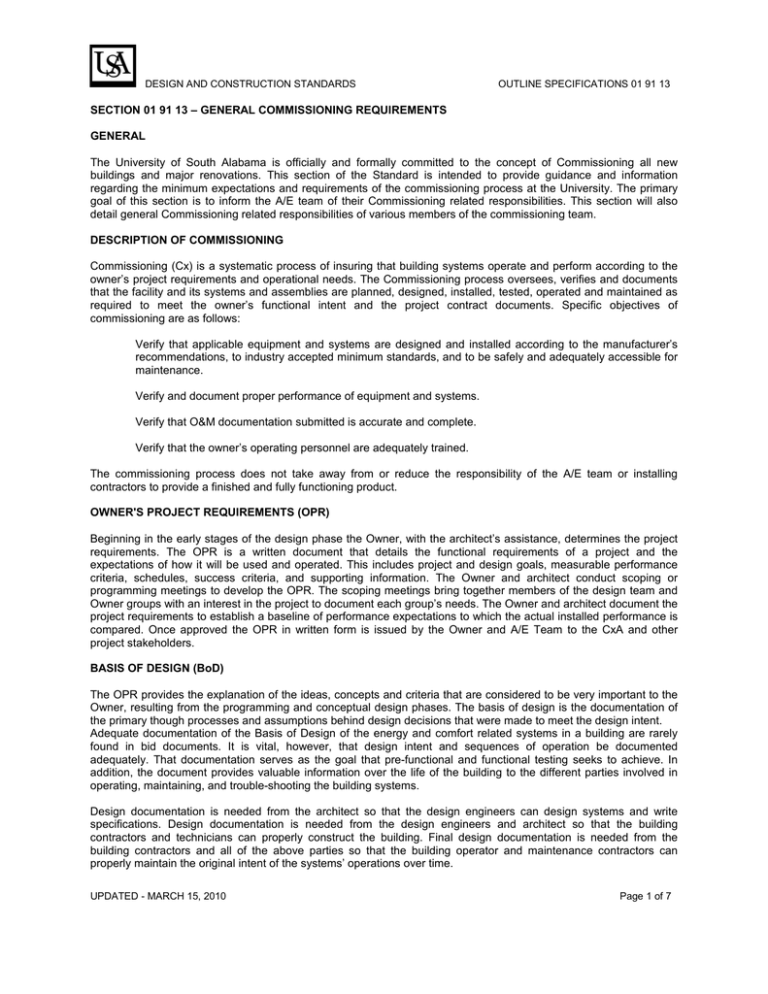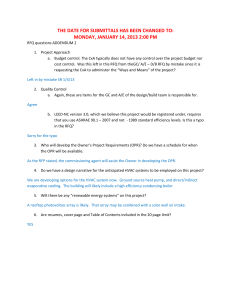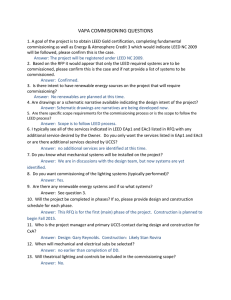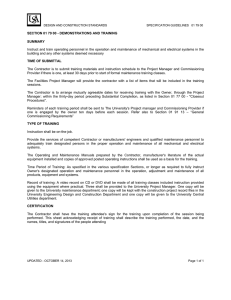Document 11171650
advertisement

DESIGN AND CONSTRUCTION STANDARDS OUTLINE SPECIFICATIONS 01 91 13 SECTION 01 91 13 – GENERAL COMMISSIONING REQUIREMENTS GENERAL The University of South Alabama is officially and formally committed to the concept of Commissioning all new buildings and major renovations. This section of the Standard is intended to provide guidance and information regarding the minimum expectations and requirements of the commissioning process at the University. The primary goal of this section is to inform the A/E team of their Commissioning related responsibilities. This section will also detail general Commissioning related responsibilities of various members of the commissioning team. DESCRIPTION OF COMMISSIONING Commissioning (Cx) is a systematic process of insuring that building systems operate and perform according to the owner’s project requirements and operational needs. The Commissioning process oversees, verifies and documents that the facility and its systems and assemblies are planned, designed, installed, tested, operated and maintained as required to meet the owner’s functional intent and the project contract documents. Specific objectives of commissioning are as follows: Verify that applicable equipment and systems are designed and installed according to the manufacturer’s recommendations, to industry accepted minimum standards, and to be safely and adequately accessible for maintenance. Verify and document proper performance of equipment and systems. Verify that O&M documentation submitted is accurate and complete. Verify that the owner’s operating personnel are adequately trained. The commissioning process does not take away from or reduce the responsibility of the A/E team or installing contractors to provide a finished and fully functioning product. OWNER'S PROJECT REQUIREMENTS (OPR) Beginning in the early stages of the design phase the Owner, with the architect’s assistance, determines the project requirements. The OPR is a written document that details the functional requirements of a project and the expectations of how it will be used and operated. This includes project and design goals, measurable performance criteria, schedules, success criteria, and supporting information. The Owner and architect conduct scoping or programming meetings to develop the OPR. The scoping meetings bring together members of the design team and Owner groups with an interest in the project to document each group’s needs. The Owner and architect document the project requirements to establish a baseline of performance expectations to which the actual installed performance is compared. Once approved the OPR in written form is issued by the Owner and A/E Team to the CxA and other project stakeholders. BASIS OF DESIGN (BoD) The OPR provides the explanation of the ideas, concepts and criteria that are considered to be very important to the Owner, resulting from the programming and conceptual design phases. The basis of design is the documentation of the primary though processes and assumptions behind design decisions that were made to meet the design intent. Adequate documentation of the Basis of Design of the energy and comfort related systems in a building are rarely found in bid documents. It is vital, however, that design intent and sequences of operation be documented adequately. That documentation serves as the goal that pre-functional and functional testing seeks to achieve. In addition, the document provides valuable information over the life of the building to the different parties involved in operating, maintaining, and trouble-shooting the building systems. Design documentation is needed from the architect so that the design engineers can design systems and write specifications. Design documentation is needed from the design engineers and architect so that the building contractors and technicians can properly construct the building. Final design documentation is needed from the building contractors and all of the above parties so that the building operator and maintenance contractors can properly maintain the original intent of the systems’ operations over time. UPDATED - MARCH 15, 2010 Page 1 of 7 DESIGN AND CONSTRUCTION STANDARDS OUTLINE SPECIFICATIONS 01 91 13 The design documentation evolves from more general descriptors during the conceptual design, to more specific descriptors during actual design, to in-depth and specific descriptors during the specifying stage. The design documentation is completed by fine tuning and adding further detail and specificity for some components during the as-built documentation stage. Though design documentation for some components cannot be completed until the end of building construction, it is not warranted to allow design documentation to be general or incomplete prior to construction. Design documentation should be as firm and complete as possible as early as possible. TIMELINE OF COMMISSIONING For most projects at the University, the Cx process will begin at the beginning of the schematic design phase and continue through and conclude at the end of the first year warranty period. The University will contract directly with the Commissioning Consultant, herein referred to as the Commissioning Authority (CxA). The CxA will be independent of the design and construction teams. The CxA will report to the University Project Manager. The University's Project manager will develop and distribute the Cx Statement of Work (SoW) and Request for Proposal (RFP) for each project. The CxA shall manage the Cx process within the project. COMMISSIONING TEAM The members of the commissioning team shall include the University's Project Manager, the CxA, the architect, the design engineers, the general contractor and/or construction manager, the mechanical contractor, the electrical contractor, the BAS contractor, the TAB contractor, the plumbing contractor, the fire protection contractor and the fire alarm contractor, if different from the electrical contractor. Other members of the Cx Team include the LEED consultant if provided and personnel of the University's ED and C staff. Each Cx Team member shall assign one individual to be the primary point of contact for the commissioning process. COMMISSIONING PROCESS OVERVIEW AND RESPONSIBILITIES DESIGN PHASE The following are general design phase expectations and responsibilities of specific Cx Team members: Owner (University of South Alabama) Produces the Owners' Requirements (OPR) Assign operations and maintenance personnel and schedule them to participate in the various meetings, training sessions, and site observations/inspections. Review and approve any changes made to the Owner's Project requirements. Review and comment on the commissioning authority's Commissioning Cx plan. A/E Team: Provide the CxA the Basis of Design (BoD) for systems being commissioned. Respond to any resulting review questions pertaining to the CxA’s review of the BoD. Meet with the CxA to discuss and coordinate the design phase Cx process and review the Cx Plan developed by the CxA. Incorporate into the project specifications the commissioning specifications, and any referenced attachments, provided by the CxA. Coordinate with the CxA which numbering format is being used. Respond to the design review comments provided by the CxA, TAB consultant and BAS Contractor. Provide responses prior to issue of the next progress submittal. The CxA will generally review the following submittals: 100% SD, 100% DD, 50% CD and 95% CD. The TAB consultant will generally review the 50% and 95% CD submittals. The BAS Contractor will generally review the 95% CD submittal. Meet with the CxA, as required, to discuss design review comments. UPDATED - MARCH 15, 2010 Page 2 of 7 DESIGN AND CONSTRUCTION STANDARDS OUTLINE SPECIFICATIONS 01 91 13 TAB Consultant: The University of South Alabama contracts directly on each new construction and major renovation project with the test and balance contractor directly. The University Project Manager will coordinate with the T and B contractor to review progress submittals during the design phase. The T and B contractor will forward test and balance related review comments to the University Central Utilities department and the A/E team for review. BAS Contractor: South Alabama will employ a Building Automation System (BAS) Contractor on every project. The design team will forward progress submittals to the University Central Plant for review. Final written approval of the Central Plant Department will be required before bidding. General Contractor (if identified during the design phase): With input from the CxA and TAB Consultant, incorporate TAB and Cx activities into the master construction schedule. CONSTRUCTION PHASE The following are general construction phase expectations and responsibilities of specific Cx Team members: Owner (University of South Alabama) Review and comment on the CxA's field observation reports, and deficiency log. Review and comment on the Commissioning authority's Pre-Functional and functional checklist. Review and accept the Commissioning authority's system manual and final report. All Cx Team Members: Review and provide comment on the CxA’s Cx Plan, prior to the Cx scoping meeting. Follow and adhere to the Cx Plan. Participate in the Cx scoping meeting to discuss the Cx scope, Cx Plan, coordination and schedule. This meeting shall occur approximately upon start of overhead MEP rough-in. Review and comment on the functional test procedures, scripts and checklists developed by the CxA. The CxA shall submit the tests approximately 2-3 months prior to functional testing in the field. A/E Team: Inform the CxA of any changes to the BoD or construction documents, as applicable, as related to the systems being commissioned. Distribute one copy of each subcontractor submittal to the CxA for the CxA’s review, concurrent with the engineer’s review. Coordinate submittal review comment deadlines imposed on the engineers to the CxA. The intent is that the CxA review be completed simultaneous with the engineers review and the CxA’s comments incorporated with the engineer’s comments, as applicable. Respond to Request for Information (RFI’s) from the CxA. Copy the CxA on A/E observation reports. Distribute to the CxA one copy of the O&M Manuals and As-Builts submitted by the construction team Assist the Cx Team to resolve any issues or concerns identified during the construction phase. UPDATED - MARCH 15, 2010 Page 3 of 7 DESIGN AND CONSTRUCTION STANDARDS OUTLINE SPECIFICATIONS 01 91 13 General Contractor: Ensure that all Subs execute their commissioning responsibilities according to the Contract Documents and schedule. Continue to incorporate and update TAB and Cx activities into the master construction schedule. Participate in Cx coordination meetings as required. Develop, with the subcontractors, the start-up plan to be employed for each piece of equipment and system. Verify items identified in the Cx Issue log are being addressed by the responsible subcontractor. Spearhead coordination between the Subs and the CxA to witness factory testing and/or start-up. The CxA will specify in the Cx Plan which construction phase tests and startups he intends to witness, as required by his SoW. Provide the CxA copies of third party test results. The CxA will specify in the Cx Plan which test reports he plans to review, as required by his SoW. All Subcontractors: Submit to the CxA the proposed prefunctional checklists to be employed in the project. If a subcontractor does not have an acceptable prefunctional checklist for a piece of equipment or system, the CxA will provide that checklist for the Subcontractors use. Each subcontractor shall complete each approved prefunctional checklist, and submit to functional testing. the CxA prior to Respond, in writing, to any CxA submittal review comments. Participate in Cx coordination meetings as required. Respond, in writing, to each observation listed in the Cx Issue Log within 5 working days from its release from the CxA. Responses shall indicate whether the issue is agreed to and will be or has been corrected, whether more information is needed from the CxA regarding the issue, or whether there is a disagreement with the issue reported. Execute the coordinated and approved start-up plan. ACCEPTANCE PHASE The following are general acceptance phase expectations and responsibilities of specific Cx Team members: A/E Team: Assist the Cx Team to resolve any issues or concerns identified during the acceptance phase functional tests. General Contractor: Ensure that all Subs execute their commissioning responsibilities according to the Contract Documents and schedule. Continue to coordinate and incorporate Cx activities into the master construction schedule. Spearhead the response and incorporation, as agreed, to the CxA review comments of the O&M manuals submitted by the subcontractors. UPDATED - MARCH 15, 2010 Page 4 of 7 DESIGN AND CONSTRUCTION STANDARDS OUTLINE SPECIFICATIONS 01 91 13 Continue to verify items identified in the Cx Issue log or Observation report are being addressed by the responsible subcontractor. Provide the training plan and agendas proposed by the subcontractors to the CxA for review. All Subcontractors: Demonstrate functional performance, per the coordinated functional test procedures, scripts and checklists, provided by the CxA during the construction phase. In general, functional testing by the CxA shall be performed from the final graphic control screens by which University personnel will operate the facility. Continue to retest until acceptable performance is verified and documented. Provide specified testing documentation (i.e., National Fire Protection Association, NFPA) as required and as requested by the CxA. BAS Contractor: During functional testing by the CxA, alarm routing shall be to a secondary OWS computer. Upon completion of the functional tests, route the alarms as required to the primary alarm display in the OWS. Provide requested trend information to include, at minimum, all major control setpoints to demonstrate stable and accurate control. Assist the TAB Consultant and the CxA to optimize static and differential pressure control setpoints and reset limits. TAB Consultant: Assist the BAS Contractor and CxA to optimize static and differential pressure control setpoints and reset limits. Assist the CxA to conduct and document pressure mapping of the facility at the design airflows and at part load conditions to verify pressure relationship across the envelope and across partitions between all pressure critical zones are per the project requirements. WARRANTY PHASE The following are general acceptance phase expectations and responsibilities of specific Cx Team members: A/E Team: Continue to assist the Cx Team to resolve any issues or concerns identified during the first year warranty period. Provide an end of warranty timeline to the Owner. General Contractor: Assist in coordination with its Subs to perform seasonal and deferred testing, as required. All Subcontractors: Support the CxA to perform any seasonal or deferred functional testing, as required. Systems to Commission (by the CxA) COMMISSIONING EQUIPMENT AND SYSTEMS The following is a general list of the equipment and systems that are typically commissioned on University of South Alabama projects: UPDATED - MARCH 15, 2010 Page 5 of 7 DESIGN AND CONSTRUCTION STANDARDS OUTLINE SPECIFICATIONS 01 91 13 Building Envelope Systems Building Automation Systems, including linkages to remote monitoring and control sites and integration to other systems Laboratory Control Systems, including integration to the building automation system HVAC Equipment and Systems Energy Recovery Equipment and Systems Smoke Evacuation Systems Water Reclaim Systems Fire Alarm Systems Fire Protection Systems Domestic Hot Water Heating Systems Domestic Water pressure reducing stations and mixing valves Lighting and Day-Lighting control Systems Utility Metering Systems Emergency Power Systems Electrical Service and Distribution Systems Depending upon the complexity of the specific project, other systems may be included within the CxA’s SoW. Note that this list above entails the equipment and systems which fall within the third party commissioning consultants scope of work. Any equipment or systems not listed here does not imply the installing contractor is not obligated to commission his work as required by the project contract documents. USGBC LEED™ PROGRAM (if required by owner) The CxA SoW will adhere to and generally exceed the USGBC LEED™ requirements for the following credits, based upon the current version of the rating system: EA Prerequisite 1: Fundamental Commissioning of Building Energy Systems EA Credit 3: Enhanced Commissioning EQ Credit 7.2: Thermal Comfort: Verification FACILITY SHELL COMMISSIONING The Envelope Commissioning Authority (ECx) will be independent of the design and construction teams. The contract with the ECx will generally be held directly by the University, however, this contract can be held by the MEP CxA or the Architect. Consult with the assigned Project Manager and Commissioning Engineer on each project regarding contractual coordination. DESIGN PHASE RESPONSIBILITIES The ECx will review various design phase submittals. Typically, reviews will be done on the 50% and 95% CD submittals. The design reviews will focus primarily on the envelope section details shown in regards to waterproofing and air infiltration. The architect will be expected to work with and meet, as required, with the ECx to discuss review comments. The architect will also be expected to provide written response to each review comment, informing whether the correction was implemented, if more information is required from the reviewer, or if there is a disagreement with the comment. CONSTRUCTION PHASE RESPONSIBILITIES The ECx will be involved in the submittal and shop drawing review process. The architect will be expected to coordinate with the ECx to perform reviews concurrent with the architect reviews. UPDATED - MARCH 15, 2010 Page 6 of 7 DESIGN AND CONSTRUCTION STANDARDS OUTLINE SPECIFICATIONS 01 91 13 The ECx will conduct pre-construction conference(s) with the envelope construction team. During these conferences, the ECx’s submittal and shop drawing review comments will be discussed, along with general coordination and sequence of material installation. The responsible subcontractor will also be expected to provide written response to each review comment, informing whether the correction will be implemented, if more information is required from the reviewer, or if there is a disagreement with the comment. The ECx will conduct periodic site visits during construction to observe below and above grade construction. After each site visit, the ECx will provide an associated field report. The General contractor and the responsible subcontractor will be expected to address any deficiencies identified in the field reports. Written remedial action regarding each identified deficiency will also be expected by the construction team. TESTS During T and B testing, T and B contractor will test 10% of each operational system to verify their operation. The contract documents shall require the contractor to demonstrate water and air tightness on a minimum of 15% of the installed window systems. The contractor will be expected to assist and coordinate with the ECx regarding the level of support required (i.e., man-lifts, water hoses, water, chamber construction, etc.) In general, the ECx will perform to following tests on a representative sample of envelope openings: Nozzle testing per AAMA 501.2 Static Pressure Chamber testing per ASTME 1105 UPDATED - MARCH 15, 2010 Page 7 of 7





